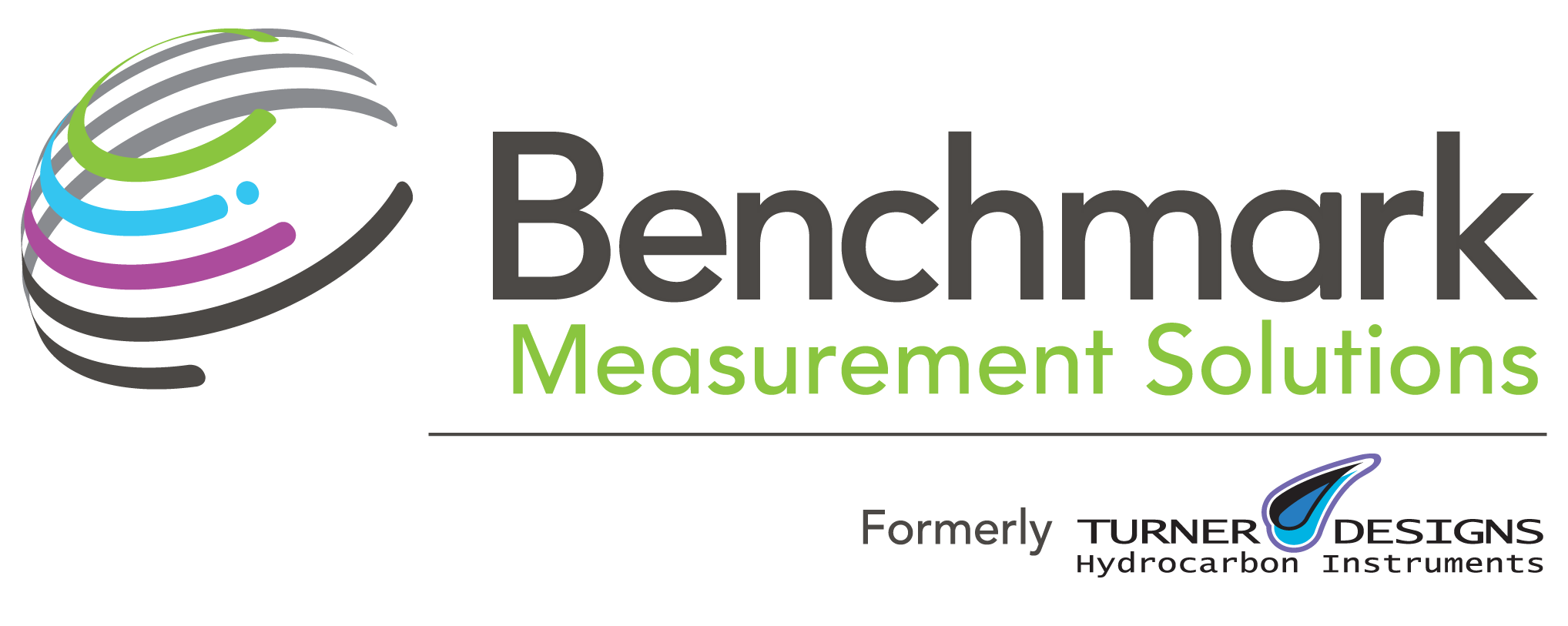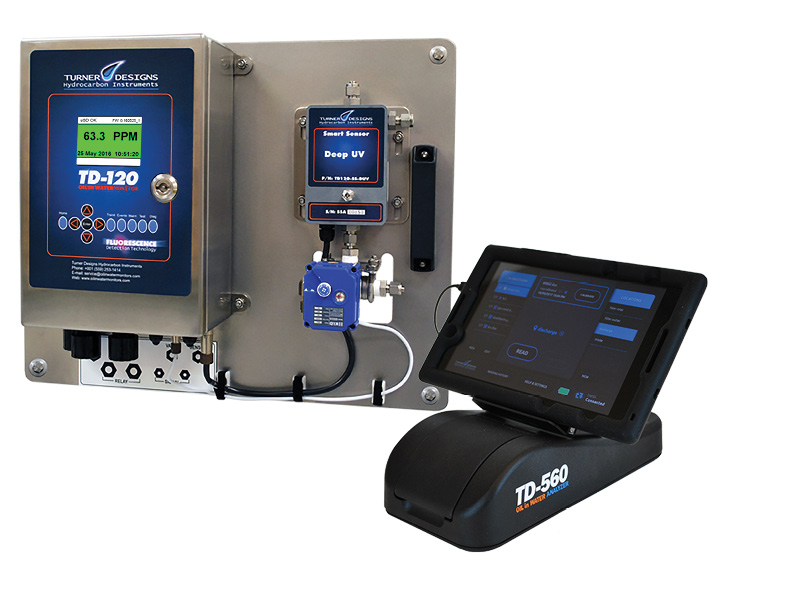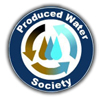Benchmark Measurement Solutions features a range of fluorescence-based oil in water monitors and analyzers. Deep ultraviolet (deep UV) light is a powerful tool for measuring oil concentrations in water due to its high energy and ability to induce fluorescence in hydrocarbons. This article focuses on the value and application of deep UV light in measuring hydrocarbon concentration.
Principle of Fluorescence
Deep UV light, typically in the range of 200-300 nanometers, is used to excite aromatic hydrocarbons present in oil. When these hydrocarbons absorb deep UV light, they become excited to a higher energy state. As they return to their ground state, they emit light at a longer wavelength, a process known as photoluminescence or fluorescence. This emitted light is then detected and measured to determine the concentration of oil.
Excitation and Emission
- Excitation: The sample containing water and potential oil contamination is exposed to deep UV light. The aromatic hydrocarbons in the oil absorb the UV light and become excited.
- Emission: The excited hydrocarbons emit light at a characteristic wavelength as they return to their ground state. This emitted light is typically in the visible or near-UV range and is directly proportional to the concentration of oil in the sample.
Detection System
The emitted fluorescence is captured by a light detector—a photomultiplier, diode array, or Smart Sensor. After light has passed through the emission filter, the detector converts the narrowed wavelength into an electrical signal, which is then processed and analyzed to quantify the oil concentration.
Calibration and Quantification
To ensure accurate measurements, the analyzer is calibrated using known concentrations of oil standards. This calibration curve allows the instrument to correlate the intensity of the fluorescence signal with the concentration of oil in the sample. By comparing the fluorescence intensity of the sample to the calibration curve, the exact concentration of oil can be determined.
Advantages of Deep UV Fluorescence
- High Sensitivity: Deep UV fluorescence can detect very low concentrations of oil, making it suitable for applications requiring high sensitivity—low ppb to 6000 ppm.
- Selectivity: The technique is highly selective for aromatic hydrocarbons, reducing interference from other substances in the water.
- Non-Destructive: The measurement process does not alter or destroy the sample, allowing for continuous monitoring.
- Rapid Response: The fluorescence response is immediate, enabling real-time monitoring and quick detection of oil contamination.
Deep UV Applied to Diverse Industries
- Produced Water Management in Refineries
Deep UV fluorescence technology is widely used in refineries to monitor and manage produced water as it is discharged or re-injected. With high sensitivity, selectivity, and rapid response capabilities, deep UV fluorescence detection systems provide accurate and reliable data for environmental monitoring, oil spill response, and produced water management. These systems help industries maintain stringent environmental standards and ensure operational efficiency, mitigating environmental impacts. - Cooling/Intake Water
Deep UV fluorescence helps in optimizing the treatment processes of closed loop and once-through cooling water systems by providing immediate feedback on contaminant levels, thereby preventing fouling, corrosion, and scaling. This application ensures the longevity and reliability of cooling water systems, maintaining operational efficiency and compliance with environmental regulations. By ensuring real-time detection of oil pollutants, these monitors aid in the protection and maintenance of cooling systems, preventing operational disruptions caused by fouling and corrosion. - Desalination
The use of deep UV fluorescence in desalination processes helps in safeguarding intake water quality and protecting vital treatment equipment from contamination, ensuring operational efficiency. It provides real-time monitoring capabilities, allowing for immediate detection of pollutants and enabling prompt corrective actions. This application helps in maintaining compliance with regulatory standards, optimizing treatment processes, and protecting equipment—such as reverse osmosis membranes— from contamination. - Gas Condensate in Water Processes
Deep UV fluorescence technology offers precise detection and measurement of gas condensate concentrations in water systems. This application is crucial for maintaining the quality of processed water, ensuring compliance with industry regulations, and preventing potential environmental harm. The high sensitivity and specificity of the technology allow for accurate quantification of even trace levels of gas condensates, facilitating more effective process control and mitigation of contamination risks.
Deep UV Fluorometers from Benchmark
Key Features of Benchmark Measurement Solutions
- Precision: Its analyzers provide reliable measurements with high precision, calibrated against certified oil standards to ensure accuracy across various operating conditions.
- Sensitivity: The instruments are designed to detect even trace amounts of hydrocarbons, making them suitable for sensitive applications like spill detection and compliance monitoring.
- Robust Design: Built to withstand harsh operational environments, these monitors feature durable materials and components that ensure long-term reliability and minimal maintenance.
- Real-time Monitoring: Equipped with advanced electronics and software, these systems provide continuous monitoring and immediate feedback, allowing operators to promptly address contamination issues.
- User-friendly Interface: The devices offer intuitive interfaces that facilitate ease of use and data interpretation, supported by comprehensive software for detailed analysis and reporting.
Benchmark Measurement Solutions’ deep UV fluorescence detection systems embody technological excellence, delivering reliable and precise measurements, enhancing environmental protection, and ensuring compliance across various industrial applications. Their advanced monitoring capabilities, including photoluminescence techniques and robust design, make them indispensable tools for modern hydrocarbon detection and monitoring.
TD-120
The TD-120 is Benchmark Measurement Solutions’ online deep UV fluorescence monitor, designed for continuous detection of hydrocarbon concentrations in various water matrices. This model is optimized for applications requiring reliable and affordable detection capabilities without compromising on performance.
- Compact and portable design, suitable for most industrial applications
- Easy to use interface and straightforward operation is ideal for all levels of technical expertise
- High sensitivity, capable of detecting trace levels of hydrocarbons to meet stringent regulatory standards
- Extended application range—<1 ppm to 6000 ppm—useful for applications such as monitoring effluent water quality, tracking localized spill events, and ensuring compliance in small-scale operations
- New auto-valve capabilities including temperature protection, fresh water flush, and process isolation
- Analog signal, alarm dry contact relays
- Optional sea water compatible wetted parts
- Minimal maintenance
- Low cost of ownership—no reagents or instrument air needed for operation
- Internal tablet interface for quick setup and calibration
TD-560
Benchmark’s TD-550 Oil in Water Analyzer is best suited for applications where a a wide concentration range is more important than high sensitivity, such as analyzing produced water samples. The TD-560, includes the near UV channel found in the TD-550 and adds a second, deep UV, channel for precise measurement of light hydrocarbons, such as BTEX, gas condensates, gasoline, jet fuel, kerosene, transformer oils, styrene and phenol.
Both of these analyzers reflect Benchmark Measurement Solutions’ commitment to delivering high-quality fluorescence detection systems that cater to a wide array of industrial needs, ensuring precision, reliability, and ease of use across various applications. Each analyzer includes the following features.
- Enhanced Sensitivity for detecting lower concentrations of hydrocarbons—low ppb to 5000 ppm
- Low cost per sample analysis
- Large full-color touch screen interface
- Advanced data logging and graphing capabilities
- Compatibility with all popular extraction solvents
- Results can be correlated to official lab methods such as USEPA 1664A and ISO 9377-1
- Multipoint calibration and multiple calibration storage capabilities
Future Trends and Innovations
As industry demands for higher sensitivity and more rigorous environmental compliance continue to grow, the evolution of deep UV fluorescence technology is expected to follow suit. Emerging trends point towards the development of more advanced sensors and analyzers with enhanced detection capabilities and greater automation. Innovations might include networked detection systems enabling integrated monitoring across multiple sites, as well as enhanced data analytics for predictive maintenance and better process optimization.
Moreover, the integration of deep UV fluorescence detection with other analytical techniques could provide a more comprehensive understanding of water quality and hydrocarbon contamination. Coupled with advancements in data visualization and machine learning, these integrated systems will offer more insightful and actionable information for industrial and environmental applications.
In summary, deep UV fluorescence technology stands out for its specificity, sensitivity, low operational costs, ease of use, and rapid response capabilities. Its benefits span multiple industries, providing invaluable data for ensuring environmental compliance, optimizing processes, and protecting vital infrastructure. As technological advancements continue, the potential applications and efficacy of deep UV fluorescence detection systems are poised to expand further, affirming their role as a cornerstone in water quality monitoring and hydrocarbon detection.
The diverse range of Benchmark deep UV fluorescence analyzers and monitors provides multiple methods for monitoring oil and hydrocarbon contamination in a variety of water management systems, making these rugged instruments invaluable for industrial and environmental applications. Their high sensitivity, selectivity, low operation costs, minimal maintenance, ease of use and non-destructive nature make them indispensable tools in industries requiring stringent quality control and environmental compliance. By enabling real-time monitoring and rapid detection, deep UV analyzers and monitors ensure operational efficiency, regulatory adherence, and enhanced safety.




